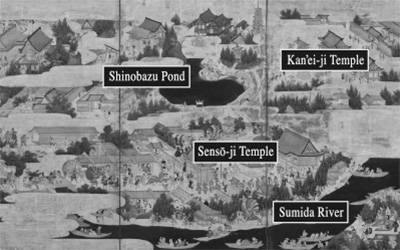The reason traditional arts and crafts are abundant in Taito
Sensōji Temple, it is told, was founded in the year 628; thereafter, Dōtōgaran (buildings within a temple complex) were erected, for which artisans gathered in the vicinity. With the emergence of the Edo Shogunate, Kan’ei-ji Temple was constructed in Ueno in Kanei 2 (1625), and temples sprung up all over Taito ward, showing the prosperity of the town around that temple gate.
The “Great Fire of Meireki” occurred in Meireki 3 (1657), when almost the whole of the city burnt down, including Edo castle. This was an opportunity to reorganize and extend the urban area of Edo. Artisans and tradespeople gradually moved into Asakusa and Ueno too (areas within present-day Taito ward).
After the Great Fire of Meireki, the Yoshiwara pleasure quarter near Nihonbashi was shifted to Asakusa, and then, during the Tenpō Reforms (1830-1843), the Kabuki and Ningyo Jōruri (puppet) theatres moved to Asakusa Shōten-chō which was renamed Saruwaka-chō; these were joined with the Okuyama, that already existed within the Sensōji Temple precincts, to ensure Asakusa flourished as the leading amusement district in Edo. Additionally, writers and artists such as Sakai Hōitsu (1761-1829) were living in Yanaka and Negishi, which meant artisans’ skills were sought for new cultural creativity.
It was upon this historical background that many artisans collected in Taito ward, whose skills have been passed down and kept alive to the present day, and the region has now become the centre for the craft industry in Japan.
(Idemitsu Museum of Arts)
 The Folding Screen of “Famous Views of Edo”, a renowned image capturing Edo as castle town prior to the Great Fire of Meireki 3 (1657), enables us to observe the appearance of Kan’ei-ji Temple (upper right) in Ueno and Sensōji Temple (lower middle) in Asakusa during the Kan’ei Period (1624-1645).
The Folding Screen of “Famous Views of Edo”, a renowned image capturing Edo as castle town prior to the Great Fire of Meireki 3 (1657), enables us to observe the appearance of Kan’ei-ji Temple (upper right) in Ueno and Sensōji Temple (lower middle) in Asakusa during the Kan’ei Period (1624-1645).
The areas where Kan’ei-ji Temple (its precincts encompass Ueno Park) and Sensōji Temple are located and portrayed on the Folding Screen of “Famous Views of Edo” coincide with the business and cultural centers in Taito ward that are modern-day Ueno and Asakusa. We can see how the roots of the development of traditional arts and crafts in Taito ward date back to the beginning of the Edo Period as depicted in this painting.
